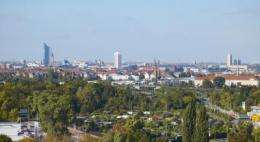Plant species living in urban backyards are closer related to each other and live shorter than species in the countrysid

Cities in both, the US and Europe harbour more plant species than rural areas. However, plant species of urban areas are closer related to each other and often share similar functions. Consequently, urban ecosystems should be more sensitive towards environmental impacts than rural ecosystems. This is concluded by German and US scientists based on a field study in Minneapolis (Minnesota) led by Jeannine Cavender-Bares, Associate Professor at the University of Minnesota. The new study confirms results obtained by Dr. Sonja Knapp and colleagues of Helmholtz Centre for Environmental Research (UFZ) in a study on the German flora in 2008. The new results have been published as a preprint in Ecology and have been highlighted in the renowned science magazine Nature.
The recent study compared plant diversity in private yards of the Twin Cities metropolis Minneapolis-St. Paul in the Midwest of the United States with plant diversity at the nearby Cedar Creek Ecosystem Science Reserve, part of the Long-Term Ecological Research network supported by the U.S. National Science Foundation. Cities are growing around the world, and understanding how urbanization and urban gardening impact biodiversity and ecosystem services is increasingly important. Scientists from the University of Minnesota, UFZ in Halle and Max-Planck Institute for Biogeochemistry in Jena, Germany, the University of California, and Whittier College California asked how different urban plant diversity in private yards is from the diversity of naturally occurring plants. Using a newly established global plant trait database (TRY), they found that the typical spontaneous yard species is short-lived, fast-growing, produces small seeds, uses humans as dispersal vectors, and is adapted to high temperatures.
The scientists point out that the promotion of self-pollinated species by the urban environment might result into cascading effects on pollinators: "If self-pollinating species are supported by urbanization and consequently increase their frequency in the regional species pool, fewer pollinators such as bees or butterflies will be supported" says Sonja Knapp. The scientists are also critical about invasive species that can be dispersed beyond yard boundaries. Still, cultivating more native plant species could have positive effects on the evolutionary diversity and potential of urban vegetation. "As yard plants spread into natural habitats, the ability of those ecosystems to respond to environmental change could be reduced", summarizes NATURE in its current "Research Highlights". "These results suggest that urbanites should consider gardening and harboring a higher number of native species," says Cavender-Bares.
In the 2008-study on the German flora, Sonja Knapp and colleagues analysed 14 million entries on plant occurrences in the FLORKART-database, which have been acquired by thousands of experts and volunteers. In the face of changing environmental conditions, nature conservation should not only focus on the protection of a high number of species, but also on evolutionary diversity. As urbanization will continue to shape our planet, nature conservation strategies for urban biodiversity should be developed, stated the scientists in their 2008-article in Ecology Letters.
The loss of evolutionary information will reduce species' chances to adapt to environmental changes and might, on the long term, negatively impact urban ecosystems. This assumption has now been confirmed with the Minnesotan field study.
More information: Knapp, S., Dinsmore, L., Fissore, C., Hobbie, S. E., Jakobsdottir, I., Kattge, J., King, J., Klotz, S., -McFadden, J. P. & Cavender-Bares, J. (2012): Phylogenetic and functional characteristics of household yard floras and their changes along an urbanization gradient. Ecology, in Press dx.doi.org/10.1890/11-0392.1
Journal information: Ecology
Provided by Helmholtz Association of German Research Centres















